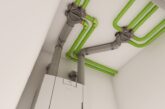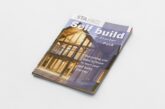
Bradley Hirst, Technical Services Manager from Knauf Insulation, provides his top three tips on insulating timber frame walls.
Timber frame walls generally provide better levels of thermal performance than external masonry cavity walls of comparable thickness.
Choose all-round performance
As ever, always use a product designed for the application. Glass Mineral Wool insulation for use in timber frame walls, such as Knauf Insulation’s FrameTherm Rolls or Slabs, will meet the thermal requirements and also offer exceptional acoustic performance. This is important because timber frame walls have less mass than external masonry cavity walls of a comparable thickness, so the insulation must also reduce noise.
Another benefit of using Glass Mineral Wool insulation is that it is non-combustible making it the safest choice because it will not contribute to the development or spread of fire should it occur.
Eliminate gaps
Save time and improve performance by choosing insulation that is easy to install correctly. Mineral Wool insulation for timber frame wall applications is pre-cut to fit 400mm or 600mm stud centres. This creates a friction-fit between the insulation, studs, and substrate eliminating air gaps. Its fibrous nature can also accommodate the natural expansion and contraction of the timber.
By contrast, rigid boards are delivered in large sheets that must be cut to size on site. This makes it extremely difficult to match the insulation board to the profile of the stud. Even if you cut to size correctly, over time air gaps can appear as the timber bows and shrinks – all of which has proven to reduce thermal, fire safety and acoustic performance.
Control condensation
In timber frame applications, warm, moist air can condense on the sheathing board around the stud. This can damage the structural integrity of the building over time by causing timbers to rot. The easy answer is to prevent condensation by installing a Vapour Control Layer (VCL) between the insulation and the plaster.
For further information on Knauf Insulation visit www.knaufinsulation.co.uk







